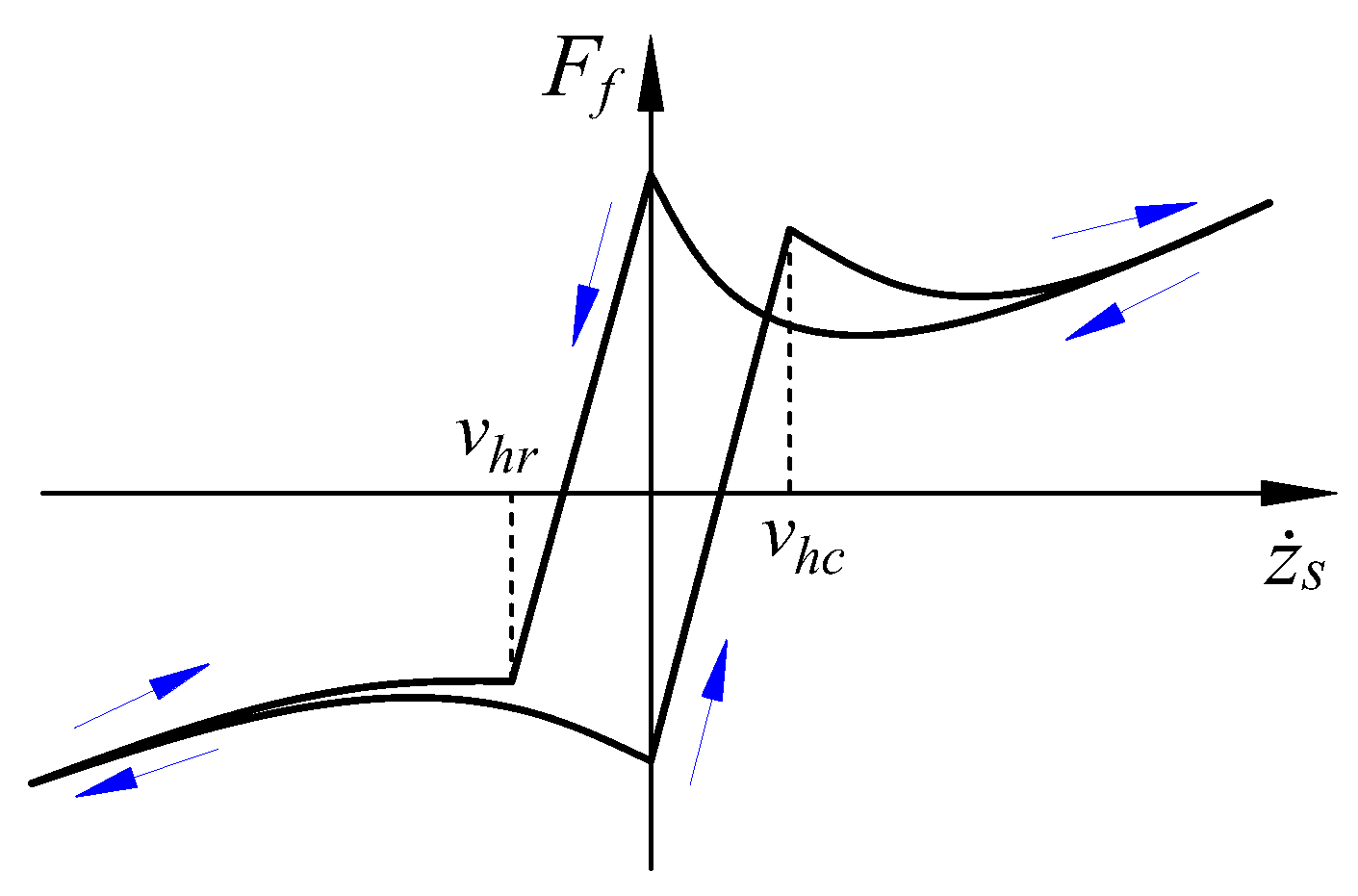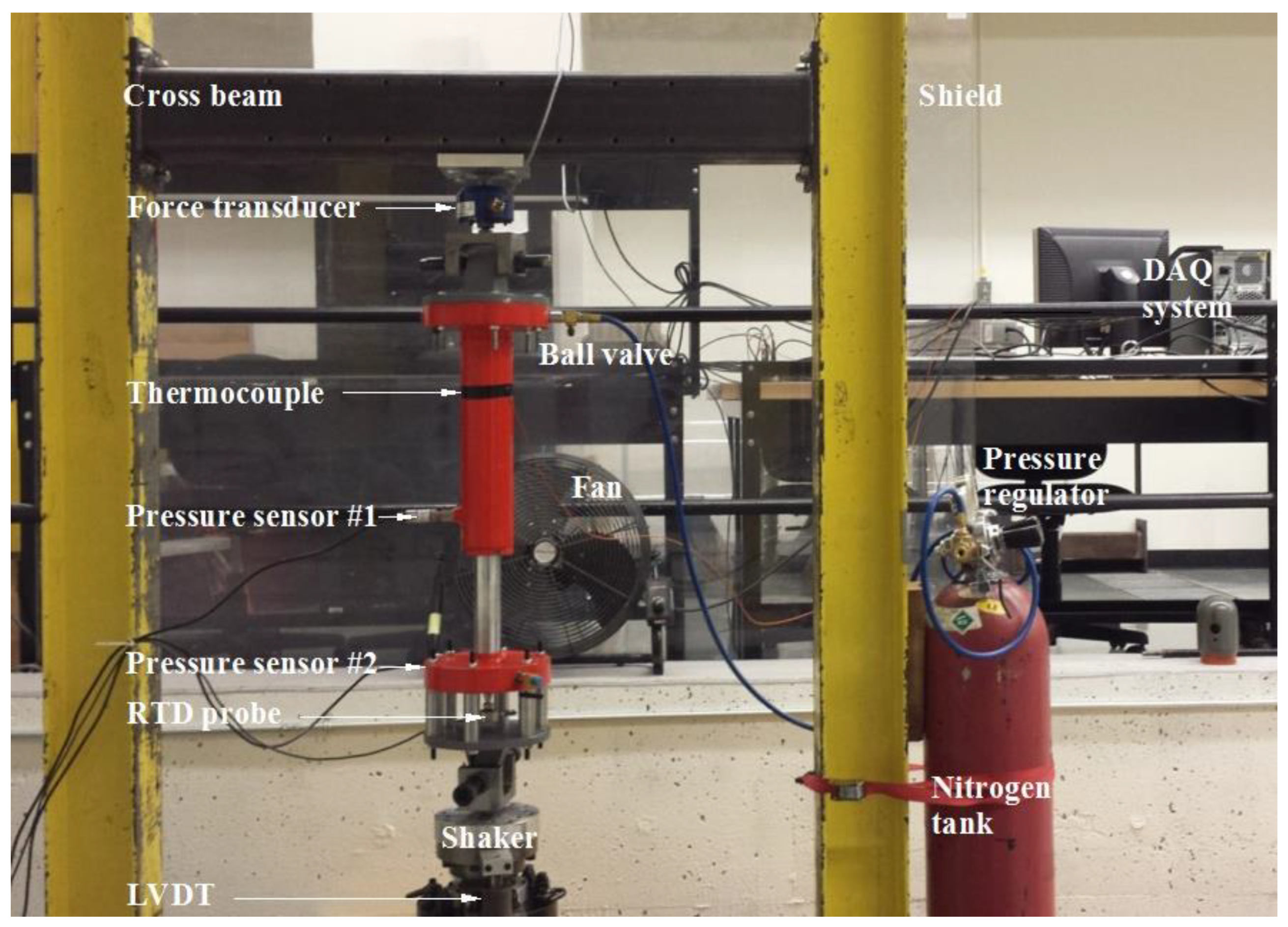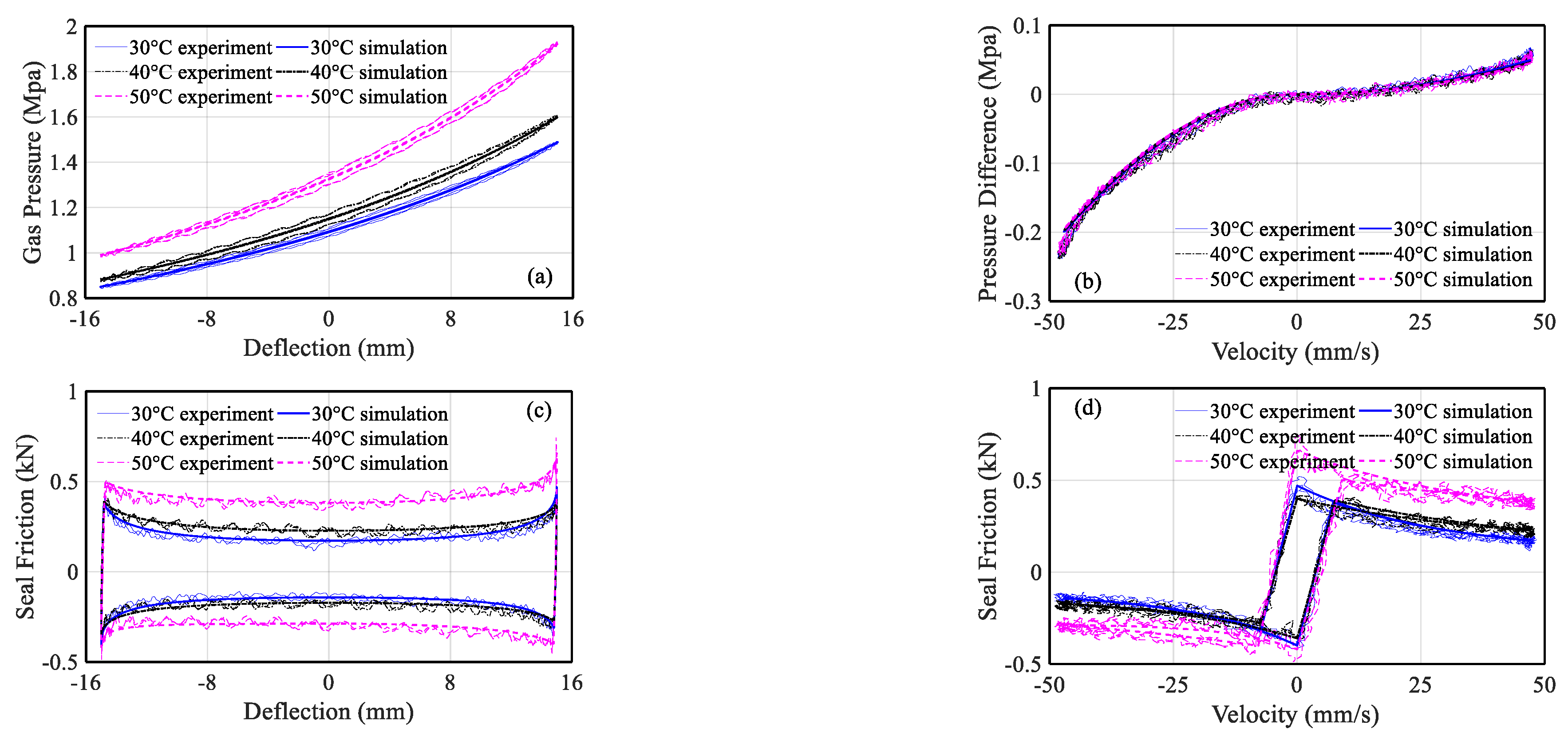Temperature- and Frequency-Dependent Nonlinearities of an Integrated Hydro-Pneumatic Suspension with Mixed Gas-Oil Emulsion Flow
Abstract
:1. Introduction
2. Related Work
3. Materials and Methods
4. Laboratory Experiments and Parameter Identification
4.1. Laboratory Experiments
4.2. Model Parameter Identification
5. Results and Discussion
5.1. Model Verification and External HPS Properties
5.2. Variations in Internal Parameters
6. Conclusions
Author Contributions
Funding
Informed Consent Statement
Data Availability Statement
Acknowledgments
Conflicts of Interest
References
- De Lima, Y.T.B.; das Neves Gomes, M.; Isoldi, L.A.; dos Santos, E.D.; Lorenzini, G.; Rocha, L.A.O. Geometric analysis through the constructal design of a sea wave energy converter with several coupled hydropneumatic chambers considering the oscillating water column operating principle. Appl. Sci. 2021, 11, 8630. [Google Scholar] [CrossRef]
- Dong, M.N.; Luo, Z.X. Statistical linearization on 2 DOFs hydropneumatic suspension with asymmetric non-linear stiffness. Chin. J. Mech. Eng. 2015, 28, 504–510. [Google Scholar] [CrossRef]
- Rehnberg, A.; Drugge, L. Ride comfort simulation of a wheel loader with suspended axles. Int. J. Veh. Syst. Model. Test. 2009, 3, 168–188. [Google Scholar] [CrossRef]
- Xu, H.; Zhao, Y.Q.; Ye, C.; Lin, F. Integrated optimization for mechanical elastic wheel and suspension based on an improved artificial fish swarm algorithm. Adv. Eng. Softw. 2019, 137, 8. [Google Scholar] [CrossRef]
- Zhang, J.; Deng, Y.; Zhang, N.; Zhang, B.; Qi, H.; Zheng, M. Vibration performance analysis of a mining vehicle with bounce and pitch tuned hydraulically interconnected suspension. Chin. J. Mech. Eng. 2019, 32, 17. [Google Scholar] [CrossRef] [Green Version]
- Cao, D.P.; Rakheja, S.; Su, C.Y. Roll- and pitch-plane coupled hydro-pneumatic suspension. Veh. Syst. Dyn. 2010, 48, 361–386. [Google Scholar] [CrossRef] [Green Version]
- Zhao, J.; Gu, Z.; Zhang, S.; Ma, X.; Zhu, Y.; Hu, K. Viscous heating of hydro-pneumatic suspension and its optimization. J. Vib. Shock. 2015, 34, 129–134. [Google Scholar]
- Shen, D.K.; Chen, Q.L.; Wang, Y.X. Dimensionless energy conversion characteristics of an air-powered hydraulic vehicle. Appl. Sci. 2018, 8, 347. [Google Scholar] [CrossRef] [Green Version]
- Morales, A.L.; Nieto, A.J.; Chicharro, J.M.; Pintado, P. A semi-active vehicle suspension based on pneumatic springs and magnetorheological dampers. J. Vib. Control 2018, 24, 808–821. [Google Scholar] [CrossRef]
- Wang, S.; Lu, Z.; Liu, X.H.; Cao, Y.; Li, X.F. Active control of hydropneumatic suspension parameters of wheel loaders based on road condition identification. Int. J. Adv. Robot. Syst. 2018, 15, 13. [Google Scholar] [CrossRef]
- Qin, B.A.; Zeng, R.Y.; Li, X.M.; Yang, J. Design and performance analysis of the hydropneumatic suspension system for a novel road-rail vehicle. Appl. Sci. 2021, 11, 2221. [Google Scholar] [CrossRef]
- Konghui, G.; Yuhang, C.; Yehai, Y.; Ye, Z.; Yanbo, J. Modeling and simulation of a hydro-pneumatic spring based on internal characteristics. In Second International Conference on Mechanic Automation and Control Engineering; IEEE: New York, NY, USA, 2011; pp. 5910–5915. [Google Scholar]
- Yang, J.; Zhao, J.F.; Shen, Y.H.; Duan, C.Y. Influence of variety of oil temperature on performance of hydro-pneumatic suspension. In Proceedings of the World-Association-of-Science-Engineering Global Congress on Science Engineering (GCSE 2010), Yantai, China, 27–28 November 2010; pp. 705–710. [Google Scholar]
- Baldi, M.C.; Meirelles, P.S. Hydropneumatic suspension design. In Proceedings of the ASME 2003 International Design Engineering Technical Conferences and Computers and Information in Engineering Conference, Chicago, IL, USA, 2–6 September 2003; pp. 2555–2563. [Google Scholar]
- Els, P.S.; Grobbelaar, B. Heat transfer effects on hydropneumatic suspension systems. J. Terramech. 1999, 36, 197–205. [Google Scholar] [CrossRef]
- Yang, J.; Yin, Y.M.; Rakheja, S.; Chu, S.H.; Chen, C.P.; Zhang, W.M. Mechanics characteristics of a kind of hydra pneumatic suspension. Nonlinear Dyn. 2019, 95, 407–419. [Google Scholar] [CrossRef]
- Yin, Y.M.; Rakheja, S.; Yang, J.; Boileau, P.E. Characterization of a hydro-pneumatic suspension strut with gas-oil emulsion. Mech. Syst. Signal Proc. 2018, 106, 319–333. [Google Scholar] [CrossRef]
- Zhang, S.; Gu, Z.Q.; Wu, W.G.; Zheng, L.D.; Liu, J.; Yin, S.B. Transient numerical investigation of a large-scale hydro-pneumatic suspension considering variations in check valve parameters and operational conditions. Int. J. Numer. Methods Heat Fluid Flow 2020, 30, 1967–1990. [Google Scholar] [CrossRef]
- Yang, C.; Song, P.; Liu, X.J. Failure prognostics of heavy vehicle hydro-pneumatic spring based on novel degradation feature and support vector regression. Neural Comput. Appl. 2019, 31, 139–156. [Google Scholar] [CrossRef]
- Wang, J.T.; Liu, Z.Y.; Xu, C.H.; Li, Z.H. Measurement method of compressibility and thermal expansion coefficients for density standard liquid at 2329 kg/m(3) based on hydrostatic suspension principle. Chin. J. Mech. Eng. 2014, 27, 779–784. [Google Scholar] [CrossRef]
- Choi, K.; Oh, J.; Kim, H.S.; Han, H.W.; Park, J.H.; Lee, G.H.; Seo, J.; Park, Y.J. Experimental study on the dynamic characteristics of hydro-pneumatic semi-active suspensions for agricultural tractor cabins. Appl. Sci. 2020, 10, 8992. [Google Scholar] [CrossRef]
- Cervelin, L.; Flesch, C.A.; Flesch, R.C.C.; Scussel, J.N.; Penz, C.A. Measurement of the friction forces between piston and cylinder in reciprocating machines using the connecting rod strain behavior. Mech. Syst. Signal Proc. 2019, 130, 677–691. [Google Scholar] [CrossRef]
- Yin, Y.M.; Rakheja, S.; Yang, J.; Boileau, P.E. Design optimization of an articulated frame steering system. Proc. Inst. Mech. Eng. Part D-J. Automob. Eng. 2018, 232, 1339–1352. [Google Scholar] [CrossRef]
- Seo, J.U.; Yun, Y.W.; Park, M.K. Magneto-rheological accumulator for temperature compensation in hydropneumatic suspension systems. J. Mech. Sci. Technol. 2011, 25, 1621–1625. [Google Scholar] [CrossRef]
- Van der Westhuizen, S.F.; Els, P.S. Comparison of different gas models to calculate the spring force of a hydropneumatic suspension. J. Terramech. 2015, 57, 41–59. [Google Scholar] [CrossRef] [Green Version]
- Liu, H.; Lee, J. Model Development of automotive air spring based on experimental research. In Proceedings of the International Conference on Measuring Technology and Mechatronics Automation (ICMTMA), Washington, DC, USA, 6–7 January 2011; pp. 585–590. [Google Scholar] [CrossRef]
- Huang, X.; Shen, Y.; Yang, J.; Zhang, W. Thermal analysis of hydro-pneumatic suspension system for dumper based on a lumped-parameter thermal model. Trans. Chin. Soc. Agri. Eng. 2013, 29, 64–70. [Google Scholar]
- Huang, X.; Yang, J.; Shen, Y.; Zhang, W. Characteristic analysis of oil temperature in a hydropneumatic suspension based on multiple regions. Chin. J. Mech. Eng. 2015, 37, 950–954. [Google Scholar]
- Jiao, N.; Guo, J.J.; Liu, S.L. Hydro-pneumatic suspension system hybrid reliability modeling considering the temperature influence. IEEE Access 2017, 5, 19144–19153. [Google Scholar] [CrossRef]
- Zhou, C.; Liu, X.H.; Xu, F.X.; Chen, W. Sliding mode switch control of adjustable hydro-pneumatic suspension based on parallel adaptive clonal selection algorithm. Appl. Sci. 2020, 10, 1852. [Google Scholar] [CrossRef] [Green Version]
- Zhang, X.L.; Liu, J.C.; Nie, J.M.; Wei, H.; Chen, L. Simulation analysis and experiment research on hydro-pneumatic isd suspension. Shock Vib. 2021, 2021, 2095350. [Google Scholar] [CrossRef]
- Lee, S.J. Development and analysis of an air spring model. Int. J. Automot. 2010, 11, 471–479. [Google Scholar] [CrossRef]
- Chang, F.; Lu, Z.H. Dynamic model of an air spring and integration into a vehicle dynamics model. Proc. Inst. Mech. Eng. Part D-J. Automob. Eng. 2008, 222, 1813–1825. [Google Scholar] [CrossRef]
- Hassani, V.; Tjahjowidodo, T.; Do, T.N. A survey on hysteresis modeling, identification and control. Mech. Syst. Signal Proc. 2014, 49, 209–233. [Google Scholar] [CrossRef]
- Kim, S.; Murrenhoff, H. Measurement of effective bulk modulus for hydraulic oil at low pressure. J. Fluids Eng. Trans. 2012, 134, 10. [Google Scholar] [CrossRef]
- Czop, P.; Slawik, D. A high-frequency first-principle model of a shock absorber and servo-hydraulic tester. Mech. Syst. Signal Proc. 2011, 25, 1937–1955. [Google Scholar] [CrossRef]
- Gholizadeh, H.; Bitner, D.; Burton, R.; Schoenau, G. Modeling and experimental validation of the effective bulk modulus of a mixture of hydraulic oil and air. J. Dyn. Syst. Meas. Control Trans. 2014, 136, 14. [Google Scholar] [CrossRef]
- Els, P.S.; Grobbelaar, B. Investigation of the time- and temperature dependency of hydro-pneumatic suspension systems. SAE Tech. Pap. 1993, 930265. [Google Scholar] [CrossRef]











| Parameter | Description | Value |
|---|---|---|
| (cm2) | Area of the piston | 44.179 |
| (cm2) | Area of the rod | 19.635 |
| (cm2) | Area of one orifice | 0.0707 |
| (cm2) | Area of one check valve | 0.041 |
| (Mpa) | Hydraulic oil bulk modulus | 1700 |
| (kg/m3) | Hydraulic oil mass density | 850 |
| (1/°C) | Hydraulic oil thermal expansion coefficient | 0.00107 |
| (Mpa/°C) | Hydraulic oil thermal coefficient of bulk modulus | 8 |
| (Ns/m) | Viscous friction coefficient | 50 |
| (m3/Pa.s) | Leakage flow coefficient | 5 × 10−12 |
| Polytropic exponent of gas | 1.4 |
Disclaimer/Publisher’s Note: The statements, opinions and data contained in all publications are solely those of the individual author(s) and contributor(s) and not of MDPI and/or the editor(s). MDPI and/or the editor(s) disclaim responsibility for any injury to people or property resulting from any ideas, methods, instructions or products referred to in the content. |
© 2023 by the authors. Licensee MDPI, Basel, Switzerland. This article is an open access article distributed under the terms and conditions of the Creative Commons Attribution (CC BY) license (https://creativecommons.org/licenses/by/4.0/).
Share and Cite
Yin, Y.; Wang, Z.; Fu, Z.; Lu, J.; Rakheja, S. Temperature- and Frequency-Dependent Nonlinearities of an Integrated Hydro-Pneumatic Suspension with Mixed Gas-Oil Emulsion Flow. Appl. Sci. 2023, 13, 3785. https://doi.org/10.3390/app13063785
Yin Y, Wang Z, Fu Z, Lu J, Rakheja S. Temperature- and Frequency-Dependent Nonlinearities of an Integrated Hydro-Pneumatic Suspension with Mixed Gas-Oil Emulsion Flow. Applied Sciences. 2023; 13(6):3785. https://doi.org/10.3390/app13063785
Chicago/Turabian StyleYin, Yuming, Zhenting Wang, Zhijun Fu, Jianshan Lu, and Subhash Rakheja. 2023. "Temperature- and Frequency-Dependent Nonlinearities of an Integrated Hydro-Pneumatic Suspension with Mixed Gas-Oil Emulsion Flow" Applied Sciences 13, no. 6: 3785. https://doi.org/10.3390/app13063785





